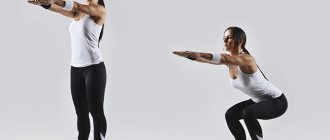A pear figure can be recognized by its wide hips with a narrow waist and small breasts. Even thin pears have hips and legs that seem heavy. It is the “pears” who are more susceptible to cellulite than others, and it is most difficult for them to lose weight in the hips. But the right workout for losing weight in your legs will help you get rid of extra pounds in the hips and buttocks.
We offer you a ready-made, effective 3-day program for “pears” without equipment, aimed at working on problem areas, fat burning and weight loss.
- Day 1: Intense Cardio for Leg Slimming (Monday)
- Day 2: Leg slimming workout without jumping (Wednesday)
- Day 3: Low Impact Workout for Slim Legs on the Floor (Friday)
Day 1 (intense cardio to lose weight in legs)
In pears, extra pounds are deposited in the hips, and in order for them to go away, you will have to do active cardio. Intense cardio training stimulates metabolism and promotes weight loss. In our leg slimming workout you will find intense functional exercises that are performed in a cardio mode for maximum results.
The first day included the following exercises:
- Jump squats with rotation: 10 reps on each side (20 squats total).
- Forward swings: 15 swings on each side (30 swings in total).
- Jumping lunges: 10 lunges on each side (20 lunges total).
- Steps in a half squat with raising your toes: 5 passes on each side (10 passes in total).
- Sprint: 30 reps on each side (60 hops total).
- Side and diagonal lunges (right leg): 10 side + 10 diagonal lunges (20 lunges total)
- Side and diagonal lunges (left leg): 10 side lunges + 10 diagonal lunges (20 lunges total)
- Double jump squats: 10 reps (20 squats total).
- Scissors with arm raises: 25 reps on each side (50 jumps total).
- Knee to stomach with back lunge (right leg): 15 reps.
- Knee to stomach with back lunge (left leg): 15 reps.
- Lateral jumps touching the floor: 10 touches on each side (20 squats in total).
The number of repetitions is approximate, you can adapt the load to your capabilities.
Jump squats with rotation
How to do it: Place your feet slightly wider than your shoulders and do a wide squat. As you rise, jump up, turning your pelvis to the left. Squat down again and jump to the right. Perform the exercise at a dynamic pace to burn fat.
How to make it easier: As part of your workout to lose weight on your legs, perform regular jump squats without turning at a moderate pace. If jumping is contraindicated, just squat and instead of turning, rise on your toes.
How much to do: 10 reps on each side (20 squats total).
Swing forward
How to do it: From a standing position, with your feet shoulder-width apart, alternately lift each leg out to the sides forward, trying to touch the toe of the opposite palm. You should not bend your knees, keep them tense and stretch them as much as possible, trying to lift them as high as possible.
How to make it easier: Bend your knees as you lift your leg up.
How much to do: 15 swings on each side (30 swings in total).
Jumping Lunges
How to do it: Place your feet together and lunge forward, jumping rather than walking. Then return to the starting position and repeat with the other leg. Perform rhythmic jumping lunges, not forgetting about technique: keep your knees bent at right angles and keep your back straight.
How to make it easier: To make your leg slimming workout a little easier, jump in place between lunges 4 times instead of 1 time. For the easiest version, perform classic forward lunges without jumping.
How much to do: 10 lunges on each side (20 lunges in total).
Half squat steps with toe raises
How to do it: Stand in a half-squat, feet shoulder-width apart, arms in front of you. Then take three rhythmic side steps. At the extreme points, lift your toes twice.
How to make it easier: At the end of the movement, do not perform a calf raise, but if it is still difficult, then do not three steps, but two.
How much to do: 5 passes on each side (10 passes in total).
Sprint
How to do it: Bend your knees slightly and place your hands in front of you, as if running. From this position, run fast and rhythmically in place at the highest possible pace.
How to simplify: If this exercise from the training for “bags” seemed too difficult, then simply slow down and run at a moderate pace. If running is contraindicated, walk quickly.
How much to do: 30 reps on each side (60 jumping jacks total).
Lunges to the side and diagonally
How to do it: Stand with your feet shoulder-width apart and keep your hands in front of you. Do a classic lunge to the side with your pelvis pulled back. Coming back, lunge back diagonally, and then lunge to the side again, and so on in a circle. Perform a whole set on one leg, then the next set on the other leg.
How to make it easier: Lunge to the side and return to the starting position (in a normal stance), and only then lunge back diagonally.
How much to do: 10 side lunges + 10 diagonal lunges (total 20 lunges on one leg), then the same amount on the other leg.
Double jump squats
How to do it: Stand in a wide stance and first do a classic squat, and then a jump squat. When squats, move your pelvis back and try to jump as high as possible.
How to simplify: If the exercise from the workout for losing weight on the legs seems very difficult, then perform jump squats every two squats (squat-squat-jump squat). If this option is also difficult, then you can do ordinary squats without jumping at a fast pace.
How long to do: 10 reps (20 squats total).
Scissors with hand raise
How to do it: Stand up straight and jump not up and down, but back and forth, alternately moving each leg, as if walking. At the same time, raise and lower each arm in turn, synchronously with the movements of your legs.
How to simplify: During the exercise, do not use your arms, only do jumping to slightly reduce the load. You can put your hands on your belt.
How much to do: 25 repetitions on each side (50 jumps in total).
Knee to stomach with back lunge
How to do it: Shift your body weight to your right leg and pull your left knee toward your stomach. Then do not return to the starting position, but immediately lunge back with your left leg. As you lunge, bend down and touch your left hand to your right foot. Perform a whole set on one side, then the next set on the other side.
How to make it easier: Raise your knee, then lower your leg to the floor, returning to your normal stance. And only then lunge from a stable position.
How much to do: 15 repetitions first on one side, then 15 repetitions on the other side.
Side jumps touching the floor
How to do it: Stand in a wide stance and bend your knees slightly, lowering yourself into a half-squat. Now perform side jumps, trying to touch the floor with your hand on each one or at least reach the level of your feet or ankles.
How to make it easier: To make your thigh-slimming workout a little easier, you can do lateral jumps without touching the floor.
How much to do: 10 touches on each side (20 squats in total).
Experienced practitioners can repeat the exercises in 2-3 circles.
Women, in their desire to lose weight or simply correct certain features of their figure, begin to fanatically engage in sports, however, they do not achieve the desired result. Why is this happening? The thing is that there are six different types of female figures, for which completely different physical exercises are suitable. But physique is not a death sentence. Everything can be changed. Fortunately, without resorting to the help of plastic surgeons.
To determine your body type, you need to stand in front of the mirror and look at yourself objectively. Having honestly determined your type, you can easily choose the fitness direction that suits you.
The recommendations below are general in nature, however, following them will help you correct your problem areas as effectively as possible. If you want not just to correct your figure, but to change radically, then you should seek advice from a professional fitness trainer who will develop for you an ideal training program that can change your body almost beyond recognition.
Rectangle or H-shaped This is your body type if:
- your shoulders, waist and hips are approximately the same width;
- you have slender legs, but practically no butt;
- a strong lean body, but small breasts and an indistinct waist.
The main advantage of this type is strong muscles that quickly respond to exercise, and leanness. In other words, girls with a rectangle body type gain excess weight with difficulty, but gain muscle mass easily. A distinctive feature of this physique is strong muscles from birth, which allows you to achieve an almost ideal body with the help of strength training.
True, in order to create seductive forms, you will have to work hard, namely: - tilting and turning will help you form those very exciting curves. Starting position - feet shoulder-width apart, arms extended above your head. The tilt is performed alternately to each leg, with your hands touching the toe and keeping your back straight. The number of repetitions is at least 20 times on each leg.
— for an H-type figure, it is worth emphasizing the need to perform additional exercises aimed at working the abdominal muscles and reducing fat deposits in this area. The most suitable exercises for this are exercises with a gymnastic hoop, a rotating circle and, of course, various crunches designed to work the abdominal muscles. The exercise should be done at least 3 sets of 20 times.
- strength classes such as BODY SCULPT are also useful. Strength exercises should be performed with fairly large weights, since your muscles will only respond adequately to intense and even exhausting training. They will give a load to the whole body and help create a strong muscle corset. Strength training should be done at least 3 times a week, and in between, be sure to do aerobics, running, race walking, swimming or dancing. The duration of strength training should be 1.5–2 hours, aerobic training - about an hour.
Rectangle (skinnier) I-shape This is your body type if:
- you have narrow hips and shoulders;
- flat stomach, poorly defined waist;
- almost complete absence of breasts and any roundness in the buttocks area.
Women with an H-shaped figure can come close to achieving a similar physique if they manage to seriously lose weight. Despite all the advantages of an I-line figure, its excessive elegance often borders on a certain angularity and a complete absence of feminine seductive forms.
To correct the shortcomings of this type of figure, you should: - do strength exercises as often as possible, ideally 4-5 times a week for 2-2.5 hours. In order to build muscle volume in the missing places, you should choose long-term strength training with heavy weights and small numbers of repetitions. Of all the possible exercises, preference should be given to those that are aimed at working all muscle groups. Such exercises include squats with dumbbells or a barbell, flexion, extension and extension of arms with dumbbells in different directions, block press from the chest, pulling a block from behind to the upper and lower back, leg swings with weights, lifting and lowering legs on exercise machines, lunges with a barbell on the shoulders, crunches from a lying position, side twists while hanging on a horizontal bar and raises on your toes. When performing such exercises, it is very important to focus on thoroughly working each muscle until you feel a slight burning sensation.
— between strength training you should leave one day of rest, since muscles grow in a calm state.
- aerobic exercise should also be present, but in a much smaller volume. Of all types of aerobic exercises, you should choose the smoothest and calmest: race walking, swimming, water aerobics, leisurely exercise on exercise bikes. Aerobic training should be done 2-3 days a week, and its duration should not exceed 20-30 minutes.
— women with an I-shaped figure can very quickly pump up beautiful, sculpted abs, since they have almost no abdominal fat. To do this, you should devote at least 20 minutes a day to abdominal development exercises, 5-6 times a week. Intensive pumping of the abdominal muscles will allow you to boast of sculpted abs after just a few months of regular training.
Triangle or V-shape (sometimes called T-shape) This is your body type if:
- your shape resembles that of an athlete or professional swimmer;
- you have long slender legs;
- thin buttocks and narrow pelvis;
- the lines of your body taper from the shoulders to the waist;
- you manage to gain weight “from above” - first your arms and face become fat, then your chest and stomach, and only then your buttocks and thighs.
Such a figure would be ideal for any man, but it gives women excessive angularity and masculinity. In addition, women with a V-shaped figure tend to have large breasts, which provokes the habit of slouching, which makes the figure even more monumental. To achieve an ideal figure, you should pump up your lower body well and lighten the entire shoulder girdle.
You can achieve a similar result: - with the help of strength and aerobic exercises, which should be alternated. Strength exercises should be given 1–1.5 hours 3–4 times a week. Aerobic workouts should be selected in such a way that they load all major muscle groups. These parameters include walking with weights, running, exercising on a treadmill or ski machine, climbing stairs or jumping rope. Aerobic training should be 40-50 minutes 3-4 times a week. You should also try to move as much as possible during the day.
- at home you can perform wide squats - 2 sets of 15-20 times. If desired, you can increase the load by picking up a fitball or dumbbells. When performing the exercise, do not forget to ensure that when squatting, your knees do not go further than your toes - only in this case the load is optimal;
— it is also useful to do swings (10-12 repetitions on each side) and lunges (three sets of 15-20 times);
Please note that women with a T-shaped figure are strictly contraindicated for any physical exercises associated with increased stress on the shoulder girdle: swimming, rowing, kickboxing and other martial arts in which the main emphasis is on punches.
Pear or A-shaped This is your body type if:
- you have very “steep” hips;
- you have a thin waist and a flat stomach;
- you have narrow shoulders and a small bust;
- excess weight is deposited exclusively below, on the hips and abdomen.
The undoubted advantage of your figure is a clearly defined waist and elegant top, but you will have to work hard with the bottom. The more you tend to be overweight, the more pronounced the discrepancy between a lush bottom and a narrow top becomes. Our task is to tighten the hips and stomach, and keep the shoulders toned.
The following workouts will help us achieve this: - It will be useful to do push-ups at home. Two sets of 8-10 repetitions. But strictly every other day.
- for the lower body, you need to choose exercises such as squats, lunges, calf raises, leg raises in various positions, leg curls, hip straightening and torso raises from a lying position. All exercises aimed at working the lower body should be performed with light weight, but a significant number of repetitions, which will allow you to quickly reduce the volume and tighten the muscles.
— we should not forget about the shoulder body. An exercise such as a “pullover” or dumbbell rows from behind the head, as well as pull-ups on uneven bars, bending arms with dumbbells in various body positions, lifting dumbbells, bench press lying or standing, turning the upper part will also help to keep the muscles of the arms and chest in good shape. body and block pull to the upper abdomen and back. Remember that all upper body exercises must be performed with heavy weights and low repetitions, which will effectively build muscle mass that is missing in these areas.
Apple or O-shaped This is your body type if:
- you have fairly thin hips and shoulders;
- slender or thin legs and proportional buttocks;
- protruding tummy.
This body type is the most difficult to work with, and achieving the desired shape can be challenging. However, if there is a desire, then there is a way: - intense aerobic exercise will help burn excess fat deposits - step, tai-bo or dance classes. You should attend classes at least three times a week.
- Don't be afraid of strength exercises. For example, you can do bench presses, dumbbell squats, or bent-leg deadlifts. Each exercise should be performed in 3-4 sets of 10-12 times. In this case, the abs will tense statically, and the stomach will tighten in “automatic mode.”
- at home you should perform body lifts with a turn, in two rounds of 20 repetitions, and front and side planks on the elbows. The time for performing the plank should be gradually increased and brought to 1.5-2 minutes.
Hourglass or X-shaped This is your body type if:
- you are the owner of rounded hips and bust;
- when you gain weight, your buttocks and lower thighs get better, but you still maintain your waist;
- you have rounded arms and legs.
Slender women with this type of figure look incredibly attractive, and even with a slight weight gain, a figure with an X-silhouette does not lose its seductive proportions and looks very harmonious, since fat deposits are deposited in the chest, shoulders, hips and buttocks, while the waist remains practically unchanged.
Therefore, when doing fitness, your main task is to maintain your feminine shape without letting it “blur”: - to keep your muscles in good shape, you should do cardio training, for example, exercise on an exercise bike, step aerobics, running, race walking, dancing, swimming, water aerobics , jumping rope. The duration of the lesson is 35-40 minutes.
— Almost all strength exercises are suitable for you, with the exception of exercises with weights aimed at working the abdominal muscles. You can create a complex workout from various squats, bends in different directions, bending and extending the legs, leg swings, flyes and curls of arms with dumbbells, barbell presses, leg lifts on the machine, pelvic lifts from a lying position, block rows to the lower and upper back , as well as various types of twists. All types of strength exercises should be performed with medium weights, since over-pumped muscles can deprive your figure of its natural smooth lines. The exercises listed above will allow you to strengthen your muscles and maintain the seductive proportions of your figure for many years.
— in the gym you can perform classic circuit training. For example, 40 seconds of aerobics (an exercise bike, running or jump rope), then pull-ups on a bar, abdominal exercises on an incline bench, back lunges with dumbbells in your hands. Each exercise should be performed 10-12 times. We recommend performing several circles per workout.
Sources - https://lady.mail.ru https://signorina.ru https://sympaty.net https://iledy.ru https://fitness4home.ru
Day 2 (weight loss workout without jumping)
To effectively lose weight, you need to keep your heart rate in the cardio zone during exercise. This can be done without jumping or running if you perform compound exercises at an intense pace. The second day of our thigh slimming program does not involve jumping, but provides an effective cardio load through multi-component functional exercises, which will help you significantly slim your thighs.
The second day included the following exercises:
- Squats with diagonal lunges: 10 lunges on each side (20 squats total).
- Side kick (right leg): 20 kicks.
- Side kick (left leg): 20 kicks.
- Spring steps from a half squat: 15 leg abductions on each side (30 leg abductions in total).
- Plank to squat raise: 10 raises from each leg (20 squat raises in total).
- Squat with shin overlap: 15 touches on each side (30 squats in total).
- Side swings: 15 swings on each side (30 swings in total).
- Back Lunge with Leg Swing (right leg): 15 reps.
- Back lunge with leg swing (left leg): 15 reps.
- Narrow squats with rotation: 10 leg abductions on each side (20 squats total).
- Low Impact Skater: 15 touches on each side (30 half lunges total).
- Knee tuck: 20 reps.
The number of repetitions is approximate, you can adapt the load to your capabilities.
Squats with diagonal lunges
How to do it: Stand in a wide stance and perform a squat, moving your pelvis back without bending your back. As you come up from the squat, take a step back and to the side, lowering into a diagonal lunge. Come back and on your next squat rise, lunge diagonally with your other leg.
How to simplify: In order to make this leg weight loss exercise easier, you can slow down the pace or avoid going into a deep squat.
How much to do: 10 lunges on each side (20 squats total).
Kick to the side
How to do it: Stand in a boxing stance, clench your hands into fists in front of you and bend your legs slightly. Then perform vigorous kicks to the side, as if punching a punching bag. At the same time, move your body back and lift your leg along the trajectory up and to the side. Perform a whole set on one side, then the next set on the other side.
How to simplify: Perform leg swings with a small amplitude, do not lift your leg high.
How much to do: 20 kicks on one side, then 20 kicks on the other side.
Springy steps from a half-squat
How to do it: Bend your knees slightly, lowering yourself into a half-squat. From this position, move your leg to the side, making pulsating movements up and down, and return back. Don't slouch, tighten your buttocks and move your pelvis back.
How to make it easier: Straighten up after every two leg abductions to relax the muscles a little.
How much to do: 15 leg abductions on each side (30 leg abductions in total).
Raise from plank to squat
How to do it: Get into a plank position with your arms straight, and then take two steps forward so that your feet are slightly behind your shoulders. Now raise your body into a classic squat. When lifting, do not change the position of your hands so that it is convenient to return to the plank. Don't forget to alternate repetitions in one approach, i.e. First, the right leg steps out of the plank first, then the left leg.
How to simplify: If an exercise from a workout for a pear body type turns out to be difficult, then try doing it slowly or not completely. The latter means that you do not need to rise into a squat. It is enough to take two steps forward and two steps back from the plank to return to the starting position.
How much to do: 10 lifts from each leg (20 squat raises in total).
Squat with shin overlap
How to do it: Stand in a wide stance and perform a sumo squat. Then, as you rise, cross your shin with your right leg and lower back into a squat. On the next lift, do a shin sweep with your left leg. Perform the exercise at a rhythmic pace.
How to make it easier: To make this thigh-slimming exercise easier, do it at a slow pace and don't squat deeply.
How much to do: 15 touches on each side (30 squats in total).
Swing to the sides
How to do it: Stand straight with your arms in front of you. Alternately lift each leg to the side until it is parallel to the floor. At the same time, the body remains stable. The leg should move in one plane along a trajectory from bottom to top and back.
How to simplify: If you cannot achieve parallelism with the floor, then raise your leg to your maximum height. You can also perform swings not with each leg in turn, but first do all the swings with one leg, and then with the other.
How much to do: 15 swings on each side (30 swings in total).
Back lunges with leg swing
How to do it: From a standing position, with your feet shoulder-width apart, lunge back. Then, without returning to the starting position, kick forward with the same leg, trying to reach the opposite palm with your leg. Perform a whole set on one side, then the next set on the other side.
How to Simplify: To make your thigh-slimming workout a little easier, break the compound exercise into two: back lunges and forward kicks. To do this, after performing a backward lunge, return to the starting position (i.e. place your working leg next to the supporting leg), and only then perform a forward kick.
How much to do: 15 reps on one leg, then 15 reps on the other leg.
Narrow squats with rotation
How to do it: Place your feet together and do a classic squat in a narrow position. At the bottom point, move your leg to the side to the left, turning your whole body after it. Come back up from the squat. On your next squat, rotate to the right.
How to simplify: To make the exercise easier, squat not to parallel with the floor and gradually increase the load.
How much to do: 10 leg abductions on each side (20 squats in total).
Low impact speed skater
How to do it: From a standing position, perform a half-lunge back diagonally, while trying to reach the foot of your front leg with the opposite hand. Perform lunges alternately with each leg at a medium pace.
How to make it easier: Perform regular diagonal half-lunges without touching your foot with your hand. This way you will reduce the load a little if the exercise from the training for “pears” turned out to be difficult for you.
How much to do: 15 touches on each side (30 half-lunges in total).
Reduction of the knees
How to do it: Place your feet wider than your shoulders and lower yourself into a deep half-squat, keep your arms in front of you, and lean your body forward slightly. Now bring your knees together until they touch each other, and then spread them as wide as possible. Try not to straighten out of the squat or bend your back.
How to simplify: Reduce the range of motion; to do this, do not bring your knees together too much. To make it easier, you can also avoid squatting too low.
How much to do: 20 repetitions.
Experienced practitioners can repeat the exercises in 2-3 circles.
Healthy lifestyle
At the beginning of the twentieth century, almost all decent training halls began to install punching bags, and the best of them were even equipped with rings with props for boxing matches. Therefore, ordinary fans of training in the gym began to ask the question: “Do I need to work and train with a punching bag every day?” The answers may be different, but all respected and experienced trainers believe that it is necessary to practice with a punching bag, since this training should be considered as one of the exercises similar to exercises for the back, abdominals, etc. Now we will tell you about the benefits of daily exercises with a punching bag.
Exercises with a punching bag help you get in a good interval workout. First you need to hit the bag for several minutes. Afterwards, rest a little, and then put on boxing gloves and approach the punching bag in such a way as to give it your all. During this exercise, an incredible amount of calories is burned, which means you effectively lose weight during such an intense workout. You will immediately feel the effect of such exercises throughout your entire body. If you hit the punching bag correctly, you will use muscles such as the abs, lower back, arms, as well as a certain part of the leg muscles, because you begin the movement for a high-quality and strong blow from the legs.
Another plus for training with a punching bag is the improvement of your figure. All representatives of boxing have simply an excellent figure, which all men simply dream of.
In addition, training with a punching bag helps you acquire self-defense skills. This is simply an excellent tool for increasing the level of self-defense, which in our turbulent times will be useful to no one. These exercises will also help you develop motor skills, coordination and improve your reaction. After all, all these qualities are simply necessary for us in everyday life.
Another benefit of such training is that it is an effective stress reliever. After all, as the practice of training processes shows, it is stress that becomes the main obstacle to achieving the goal.
Now we will try to give you some advice:
Those who have just started training with a punching bag, that is, beginners, need to take advantage of the recommendations and advice of a qualified boxing trainer. If the blow is incorrect and it is not placed at the proper level, then this can cause injury, and it can also lead to a completely opposite result. Erroneous actions that may be present in the first training sessions when placing a shot have a very bad effect on subsequent training sessions. That is why it is recommended to work with a coach at the initial stage to develop a confident technique for throwing a shot.
When training with a punching bag, you must be properly equipped and dressed. Wearing the wrong equipment can lead to serious injury and the wrong technique. What equipment and equipment should you have? Firstly: the filling of the punching bag should be made of rubber crumbs. This is necessary so that the impact is absorbed, which virtually eliminates injuries to the hands. This also requires the mandatory use of boxing or training gloves. Gloves should weigh between 400 and 450 grams.
High-quality and well-chosen equipment should effectively help you prevent possible injuries, since the impact will be absorbed. In addition to all this, you will not be afraid of pain and will be able to put into the blow with the effort that is required.
Work with a punching bag must be divided into rounds. You need to give your best in each round. When you acquire and deliver a confident blow, try to diversify your exercises with series and slopes. In this case, you need to move around the pear, increasing the pace to the maximum.
And lastly, daily training with a punching bag will add a lot to your program that has a positive effect on the entire training process. As we have already said, you will develop coordination, strength, agility, endurance, and you will also improve your self-defense skills. And this is not a complete list of all the benefits. In these workouts, as in others, the main thing is the desire to get the desired result. You need to train with full effort and dedication, and then the result will definitely come.
Day 3 (low impact workout for lean legs)
Low-impact workout for the pear body type is designed to create beautiful leg contours. With its help, you can make the outlines of your hips clearer, lift your buttocks, make your legs slimmer, without weakening your quadriceps. Also, the benefit of the training is that it does not load the joints, acting exclusively on the muscles, which allows you to target problem areas in a gentle manner.
The third day included the following exercises:
- Swing your leg up and diagonally: 20 repetitions, first on one leg, then 20 repetitions on the other leg.
- Fire hydrant leg extension: 20 reps first on one leg, then 20 reps on the other leg.
- Circular rotations with the leg: 10 rotations in one direction and 10 rotations in the other direction, then the same on the other leg.
- Pulsating lateral swings: 25 pulses first on one leg, then 25 pulses on the other leg.
- Pulse Plank Swings: 10 reps first on one leg, then 10 reps on the other leg.
- Swings from a half-sitting position: 25 repetitions, first on one leg, then 25 repetitions on the other leg.
- Kicks from a half-sitting position: 15 repetitions, first on one leg, then 15 repetitions on the other leg.
- Side plank kicks on your knees: 20 reps first on one leg, then 20 reps on the other leg.
- Circular rotations from a side plank on your knees: 10 rotations in one direction and 10 rotations in the other direction, then the same on the other leg.
- Wide scissors: 15 repetitions on each single leg (30 lifts in total).
- Synchronized circular rotations with legs: 15 rotations in one direction and 15 rotations in the other direction.
- Scissors: 20 reps on each single leg (40 lifts total).
The number of repetitions is approximate, you can adapt the load to your capabilities.
Swing your leg up and diagonally
How to do it: Get on all fours and straighten your left leg. Then lift it up and lower it diagonally to the right, trying to get it behind your supporting leg. Raise your leg up again and return to the starting position.
How to make it easier: Perform diagonal swings without bringing your legs to the starting position. To do this, simply lift your leg up and move it diagonally, then lift it again and lower it along the same path.
How much to do: 20 repetitions first on one leg, then 20 repetitions on the other leg.
Fire hydrant with leg extension
How to do it: While remaining on all fours, swing your leg bent at the knee to the side. Then straighten your leg while suspended, bend it again and return back.
How to simplify: To make the leg weight loss exercise easier, perform the fire hydrant in the classic version without straightening your legs. To do this, simply swing your leg bent to the side.
How much to do: 20 repetitions first on one leg, then 20 repetitions on the other leg.
Circular rotations with the leg
How to do it: Lie on your side and lift one leg up at a 45-degree angle. Perform circular rotations with your leg with full amplitude clockwise: forward-up-back-forward again. Then rotate counterclockwise.
How to make it easier: Perform classic leg swings while lying on your side. The main thing is to maintain an angle of no more than 45 degrees so that the load on the hips is maximum. At the lowest point, do not touch the floor with your foot, as the muscles will be in constant tension.
How much to perform: 10 rotations in one direction and 10 rotations in the other direction, then the same on the other leg.
Pulsating side swings
How to do it: Without changing position, raise your leg 45 degrees and perform light pulsating movements with your leg up and down with a small amplitude. Try to keep your leg tense so as not to reduce the load.
How to make it easier: Increase the range of motion slightly if pulsing is difficult.
How much to do: 25 pulsations first on one leg, then 25 pulsations on the other leg.
Plank swings with pulsation
How to do it: Stand in a plank position with straight arms, stomach tucked, back straight, pelvis not going up. Now lift one leg and perform a 1-2-3 pulse at the top point. Tighten your glutes and core as you perform. Advanced people may not touch the floor with their foot when lowering their leg.
How to simplify: Since this exercise from the workout for the pear body type is quite complex, it can be made simpler. To do this, perform regular swings without pulsation - touching the floor with your toes at the end of the movement.
How much to do: 10 repetitions first on one leg, then 10 repetitions on the other leg.
Swings from a half-sitting position
How to do it: Sit on the floor and lean on your right forearm. Bend your left leg at the knee and vigorously lift your right leg up, performing swings with a medium amplitude. At the bottom point, do not touch the floor with your foot to keep your leg constantly tense.
How to simplify: Since it will be difficult to keep your leg constantly suspended, you can perform swings with full amplitude - touching the floor at the bottom point of the movement.
How much to do: 25 repetitions first on one leg, then 25 repetitions on the other leg.
Kicks from a half-sitting position
How to do it: Without changing position, bend your right leg at the knee, and then straighten it forward and to the side without returning to the starting position. The leg should be constantly suspended so that the load on the hips is maximum.
How to simplify: Straighten your leg only to the side or only forward if the full version of the exercise seems difficult to perform.
How much to do: 15 repetitions first on one leg, then 15 repetitions on the other leg.
Kick kick from a side plank on your knees
How to do it: Get into a side plank position using your left arm, then lower your left knee to the floor. Bend your right leg at the knee so that in the initial position it lies on top of your left. Now lift your right leg and straighten it as if you are trying to hit a wall, and then return back.
How to make it easier: To perform the exercise from the workout for slimming your thighs in a lighter version, simply lift your leg bent at the knee and straighten it, holding it on weight, for a given number of repetitions.
How much to do: 20 repetitions first on one leg, then 20 repetitions on the other leg.
Circular rotations from a side plank on your knees
How to do it: Stay in the side plank, only now straighten your leg and perform circular rotations with a small amplitude. Remember to repeat clockwise and counterclockwise.
How to simplify: If it is difficult to perform rotations, then do classic swings. To do this, simply rhythmically lift your leg up at an acute angle.
How much to perform: 10 rotations in one direction and 10 rotations in the other direction, then the same on the other leg.
Wide scissors
How to do it: Lie on your back and lift your legs straight up. Now spread them as far apart as possible, and then bring them back, performing classic scissors with each leg in turn.
How to simplify: Reduce the amplitude of the fly, which will help reduce the load and make the exercise easier. You can place your hands under your buttocks, this will make it more convenient to hold the position.
How much to do: 15 repetitions on each leg (30 flyes in total).
Synchronized leg circles
How to do it: Without changing position, extend your legs up and perform circular rotations with each leg towards each other. First, move your legs towards the body, and then spread them and bring them together again at the end point of the movement.
How to simplify: If you can’t do the exercise from the training for “pears”, then try to make it easier, for example, do circular rotations in turn - first with one leg and then with the other.
How much to perform: 15 rotations in one direction and 15 rotations in the other direction.
Scissors
How to do it: Staying on your back, lift your legs straight up. Now do classic scissors, alternately crossing your legs with a small amplitude. When performing the exercise, you should not rush, so as not to reduce the load on the working muscles.
How to simplify: If scissoring is difficult to do, you can slightly bend your knees, this will relieve tension from the muscles.
How much to do: 20 repetitions on each leg (40 flyes in total).
Experienced practitioners can repeat the exercises in 2 circles.
How to do timed workouts:
- For the first and second days (entry level). Exercise scheme: 30 seconds of work, 30 seconds of rest. You can repeat the exercises in 2-3 circles. Ready timer 30 seconds work / 30 seconds rest.
- For the first and second days (advanced level). Exercise scheme: 30 seconds of work, 15 seconds of rest or 40 seconds of work, 20 seconds of rest. You can repeat the exercises in 2-3 circles. Ready timer 30 sec / 15 sec and ready timer 40 sec / 20 sec.
- For the third day. Exercise scheme: 45 seconds of work, 15 seconds of rest or 40 seconds of work, 20 seconds of rest. Ready timer 45 sec / 15 sec and Ready timer 40 sec / 20 sec.
To train using a timer, you can download the Tabata Timer mobile application, which allows you to set timers for training yourself. See also our selection of mobile phone apps with timers for training. In addition, the links above offer videos with ready-made timers that are convenient to practice with.
Pros and cons of the pear shape
The main advantage of this type of figure is the presence of a large amount of the hormone estrogen, which is responsible for a woman’s femininity, attractiveness and sex life. Unfortunately, this positive point can suddenly turn into a negative one, because it is estrogen that inhibits the process of fat breakdown, which leads to the appearance of fat deposits in the thighs and buttocks.
It is worth noting that with the figure in question there is no need to worry about health during menopause and menopause; they pass much easier than for other women. And this happens due to the high level of estrogen. During menopause it decreases naturally, but with a pear body type it never reaches critical levels.
Yes, a woman can develop osteoporosis, cellulite, and hot flashes. All these conditions do not pose a threat to life and health, are completely controllable and even reversible.
Doctors emphasize that if a woman with a pear-shaped figure approaches menopause with extra pounds, then more serious health problems may develop. Therefore, you need to constantly monitor your weight to avoid unpleasant consequences.










